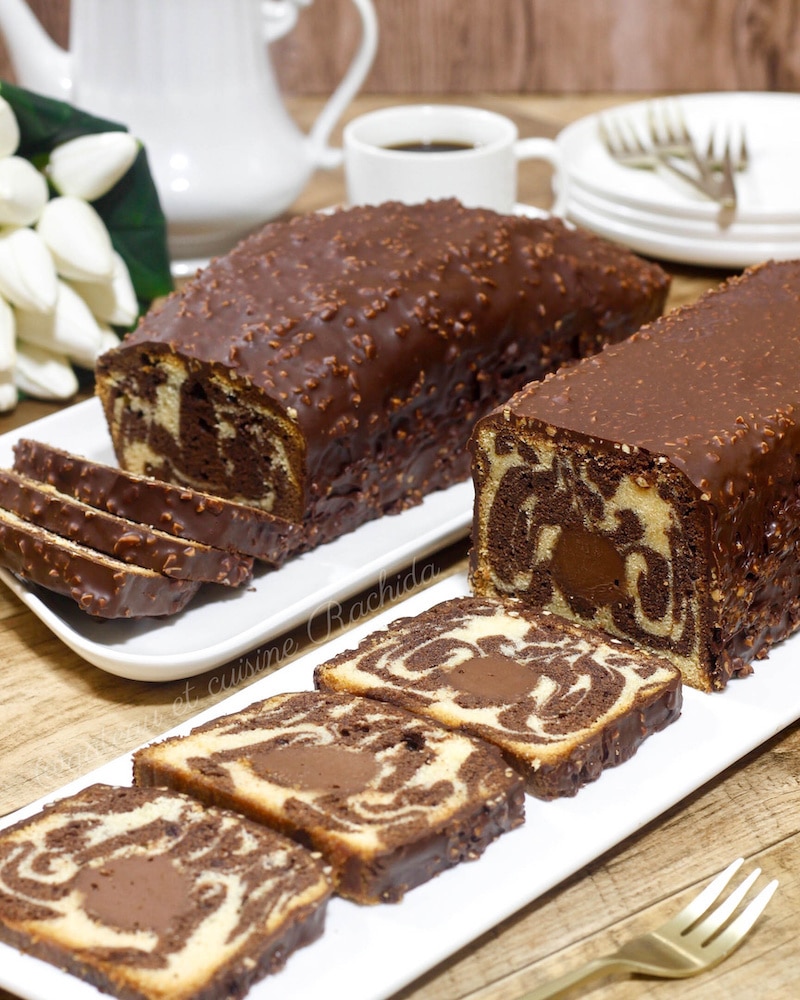
This ultra-moist cake, elevated by a chocolate and almond rocher glaze is hands down the best chocolate marble cake with beautiful swirls I’ve ever had! Its melting texture and intense vanilla flavor make it a true delight, perfect for pleasing the taste buds.
This is the ultimate Marble Cake recipe by François Perret, renowned French Pastry Chef at the Parisian luxury hotel, the Ritz. I read that even Chef Christophe Michalak considers it the best marble cake he has ever eaten.
I am very particular about cake reviews, and I can assure you that, of all the cakes I’ve made and tasted so far, this one wins hands down. It has an intense vanilla flavor that I really love!
It joins my quick and easy marble cake, which is one of my favorites!
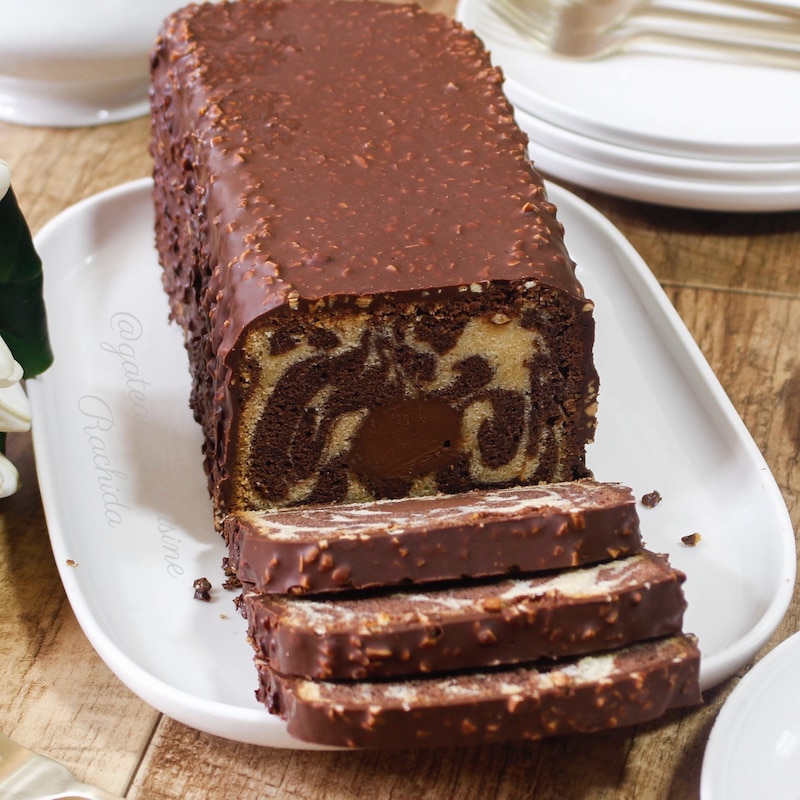
François Perret’s marble cake
Table of Contents
Tips and Timeline
The recipe is either for a loaf cake pan or a tube cake pan, your choice.
You can make this cake in one day, but for the best results, I recommend following this method, as outlined below, if you have the time.
For a standard loaf pan.
➡️ Prepare the batter the day before and leave it in the pan in the refrigerator (if you’re in a hurry, 1 hour in the freezer).
By baking the batter very cold, you create a thermal shock that promotes the optimal development of the cake and gives it that famous characteristic bump of traditional cakes. This technique is similar to the one used for madeleines to achieve their pretty bump.
To get a taller cake, you could use a smaller pan. However, this is not necessary, as the cake reaches an adequate height.
➡️ The next day, bake the cake and, as soon as it comes out of the oven, soak it with the warm syrup. Wrap it completely while still hot. The plastic wrap will trap moisture in the cake, giving you an incomparable softness.
➡️ Let it rest at room temperature for 8 hours (minimum 4 hours), either in the morning for the evening or until the next day, so the cake can absorb the syrup and the flavors can infuse.
➡️ After this resting time, place in the freezer for 2 hours and cover with hot chocolate Rocher glaze.
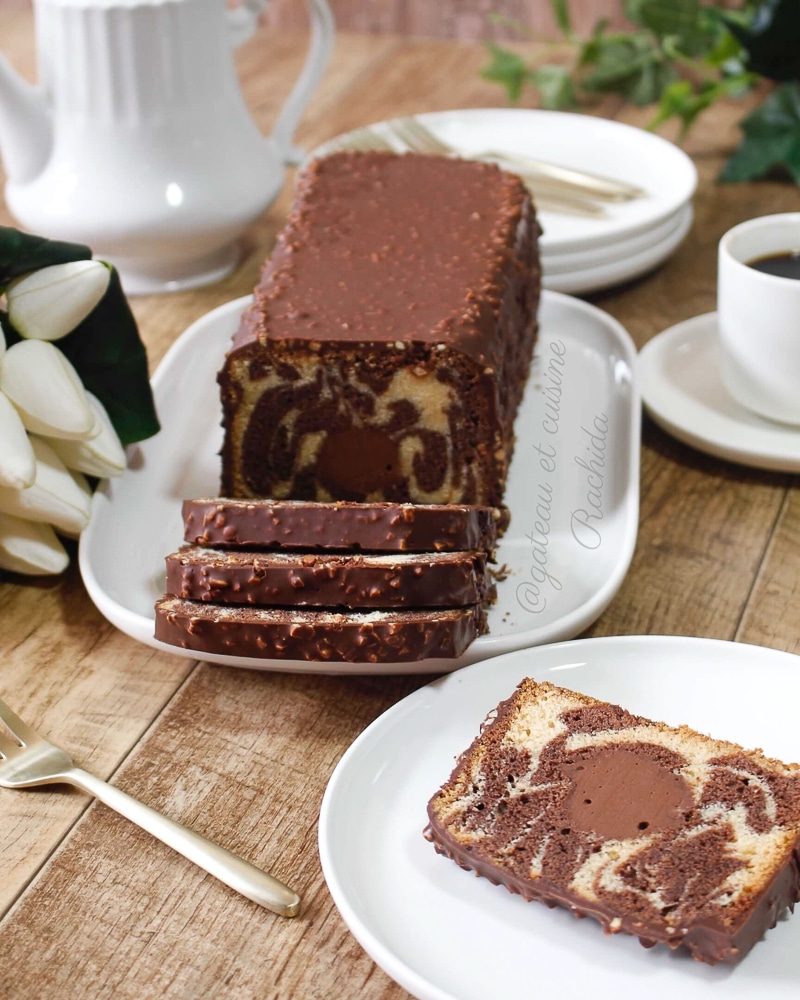
The best super moist and indulgent marble cake.
For the loaf pan with a tube
Bake immediately after finishing the preparation. For this type of pan, on the contrary, the cake needs to remain flat like a sandwich bread. In fact, this pan also has a lid.
➡️ Prepare the batter and bake immediately (there’s no need for the cake to form a dome, but rather to rise evenly). As soon as it comes out of the oven, soak it with the warm syrup. Wrap it completely while still hot.
➡️ Leave it for 8 hours at room temperature, from morning to evening, or until the next day, so the cake absorbs the syrup well and the flavors infuse.
➡️ After this resting time, fill with chocolate ganache and place in the freezer for 2 hours before covering with the warm Rocher glaze.

Video recipe:
Preparation Steps
This recipe is for a loaf pan measuring 28 x 11 x 7 cm (11 x 4.3 x 2.8 inches). I used an expandable loaf pan. If you can’t find one, a 26 cm (10.2 in) loaf pan will also work.
You can use a 25/10/9 cm (9.8/3.9/3.5 inches) loaf cake pan with a tube.
Note:
The recipe might seem long, but that’s simply because I’m explaining the steps for two different types of pans.
| NB: you can see the detailed ingredient quantities in the recipe -card at the end of this article, which you can also print out. Below are the instructions, which you can also view in images. |
You can use a food processor (blender)or a stand mixer with a paddle attachment, like a KitchenAid, to prepare the batter.
Cream the butter, sugar, and salt.
Incorporate the sifted flour (300 g / 10.6 oz) with the baking powder and mix well.
Add the eggs one at a time, mixing well after each addition.
Gradually add the heavy cream once the eggs are fully incorporated into the batter. Mix well to obtain a smooth batter.
Divide the batter into two equal parts (about 608 g / 21.5 oz each). To do this, weigh the empty bowl you’ll use beforehand.
You should end up with two portions of approximately 608 g (21.5 oz) each.
Add the cocoa powder (30 g / 1 oz) to one portion and the 15 g (0.5 oz) of flour and vanilla to the other. Mix well.
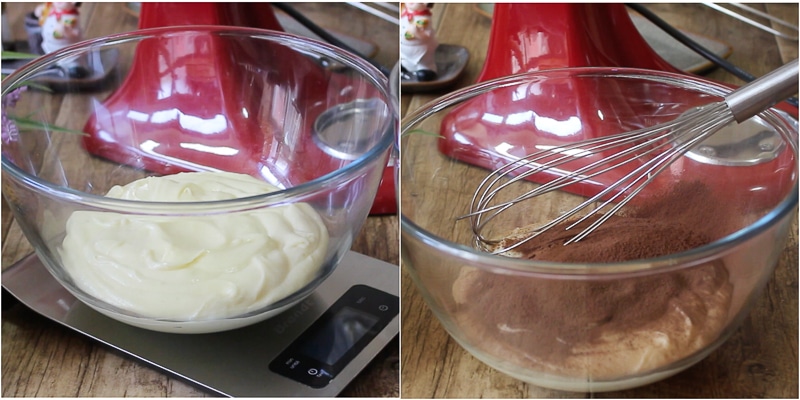
Divide the marble cake batter into two equal parts.
Place each batter in a piping bag without a nozzle or a freezer bag.
Grease and line the bottom and sides of a regular loaf pan, or grease the tube pan along with the tube and inside the lid. Line the bottom with parchment paper.
Alternate between the vanilla and chocolate batters, starting by piping the vanilla batter in the shape of a W. Then pipe the chocolate batter in the same W shape on top. Watch the video for a clearer explanation.
Tap the mold gently against the work surface to smooth the top.
Place a small amount of softened butter into a small piping bag or a freezer bag. Pipe a thin line of butter down the center of the batter, along the entire length of the mold.
Refrigerate the mold overnight, or place it in the freezer for 1 hour if you’re in a hurry.
After the chilling time, preheat the oven to 150°C (300°F) preferably with fan.
Bake for 1 hour and 30 minutes. A skewer inserted into the center of the cake should come out dry.
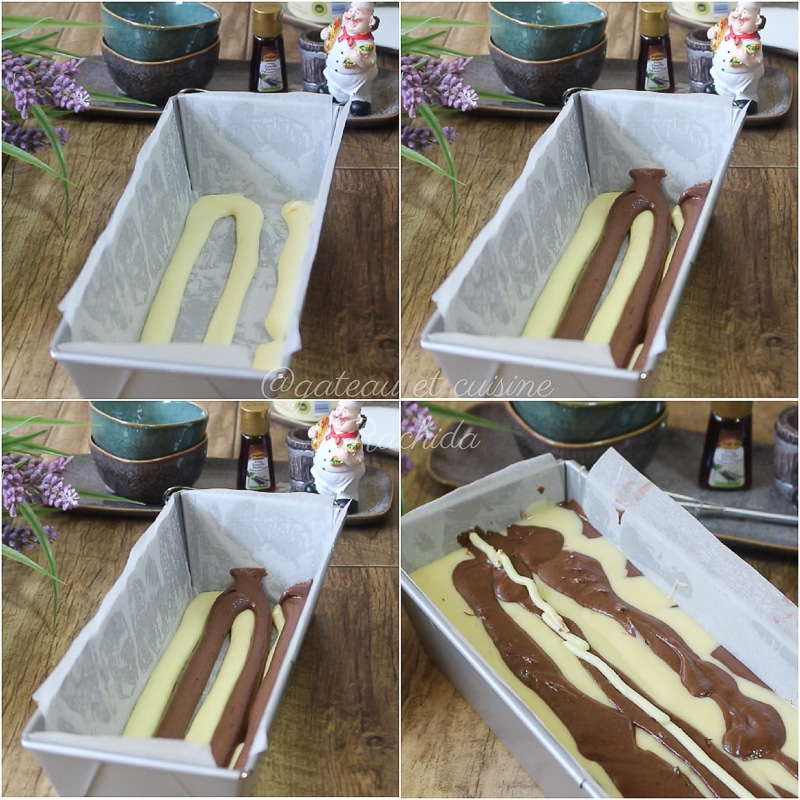
If you chose a loaf tube pan, proceed in the same way. Alternately pipe the two batters until you reach the hole, then insert the tube.
Continue piping, alternating between the vanilla and chocolate batters.
Tap the pan on the work surface to smooth the top, and close with the lid.
Bake immediately for 1 hour and 30 minutes at 150°C (300°F) (fan-assisted oven preferred).
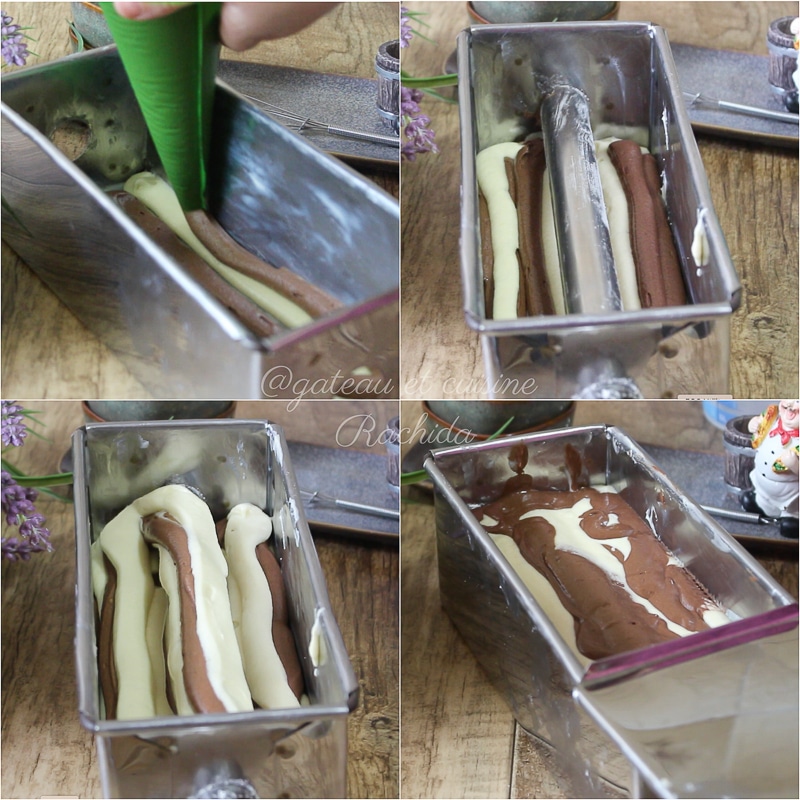
How to use a loaf tube pan to make this marble cake
Soaking syrup:
Prepare it a little before the end of the cake’s baking time, as it should be lukewarm.
Combine the water and sugar, and bring to a boil over medium heat. Stir to dissolve the sugar. Do not let it boil to avoid evaporating the water.
Remove from heat and add the vanilla extract or rum.
The finishing :
Unmold the marble cake onto a wire rack.

For the cake with a tube, wait about ten minutes, then gently remove the tube by twisting it in one direction, then the other.
Soak the warm cake with the lukewarm syrup on all sides (except the bottom).
Wait for it to lose some steam, then wrap it completely in plastic wrap.
Leave it until the next day or from morning to evening (minimum 4 hours) at room temperature.
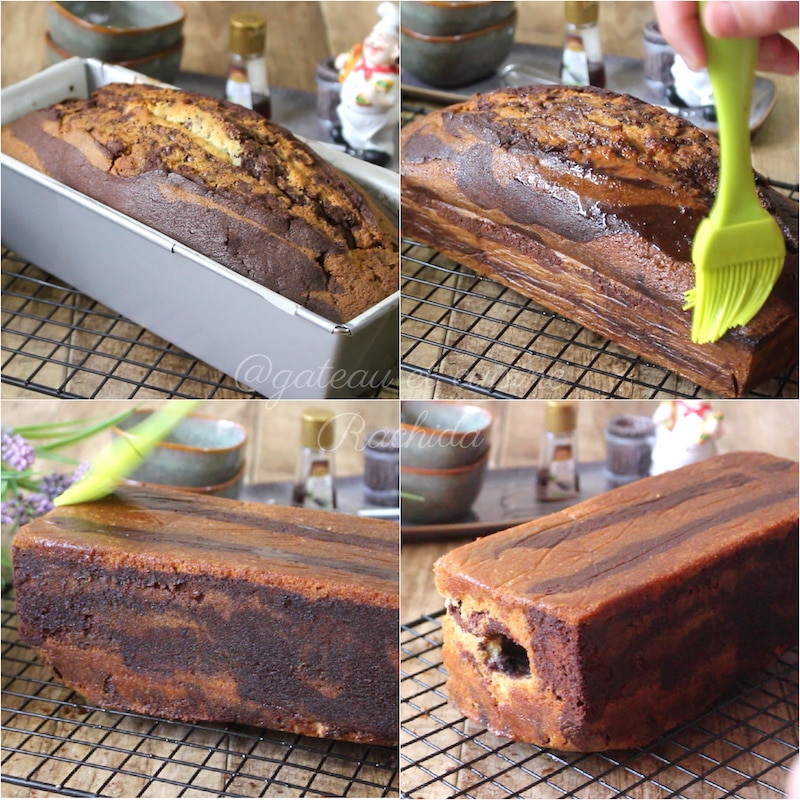
Soak the marble cake for extra moisture.
Prepare the ganache
The next day, prepare the dark chocolate ganache if you made a marble cake in the tube loaf pan. Otherwise, proceed directly to the chocolate Rocher glaze step.
Melt the dark chocolate over a double boiler. Once the chocolate is melted, heat the heavy cream with the inverted sugar or honey.
Add the hot cream to the melted chocolate in 3 or 4 stages. Stir with a spatula in a circular motion. The ganache may seem to separate, but don’t worry, this is normal.
Continue adding the rest of the cream until you have a smooth, glossy ganache.
You can use an immersion blender, trying not to create air bubbles.
Place the ganache in a piping bag.

Remove the plastic wrap from the cake, then wrap one side of the cake tightly. If necessary, double the plastic wrap to seal the gap and prevent the chocolate ganache from spilling out.

Place the cake vertically (standing upright) in a container that can hold it steady.
Fill the hole with the ganache, which should be liquid but not too runny. Fill it to the top.
Refrigerate for about 15 minutes and add more ganache if necessary, as it may settle slightly.
Freeze the cake with the ganache in this position for 1 to 2 hours to make it easier to glaze.
If you opted for a cake without ganache, freeze it as well for 1 to 2 hours.
The thermal shock will allow the glaze to adhere to the cake, and this way, you can use the hot glaze. It will flow smoothly without forming any clumps of glaze on the cake.

Rocher Glaze
Roast the finely diced blanched almonds for about 15 minutes in a preheated oven at 160°C (320°F) and let them cool.
Melt the chocolate in a double boiler. When melted, add the oil and mix well.
Remove from heat, add the roasted almonds and mix well.
Place a wire rack on a tray lined with two sheets of aluminum foil. These two sheets will catch the glaze and allow you to pour it back over the cake.
This step should be done quickly before the glaze sets on the cake.
Remove the cake from the freezer and put it on the wire rack.
Pour the glaze over the entire surface to cover it completely. Pour back any excess that has spilled onto the sheets. With this method, you’ll have a generous layer of glaze.
Tap the rack to spread the glaze evenly. I recommend not using a spatula. I did it on one side, and it left marks.
Slide two large spatulas under the cake and transfer it to the serving platter. Do this once the rocher glaze has stopped flowing.
Let it sit at room temperature before enjoying.

This marble cake will be greatly appreciated for a birthday snack or to impress your guests.
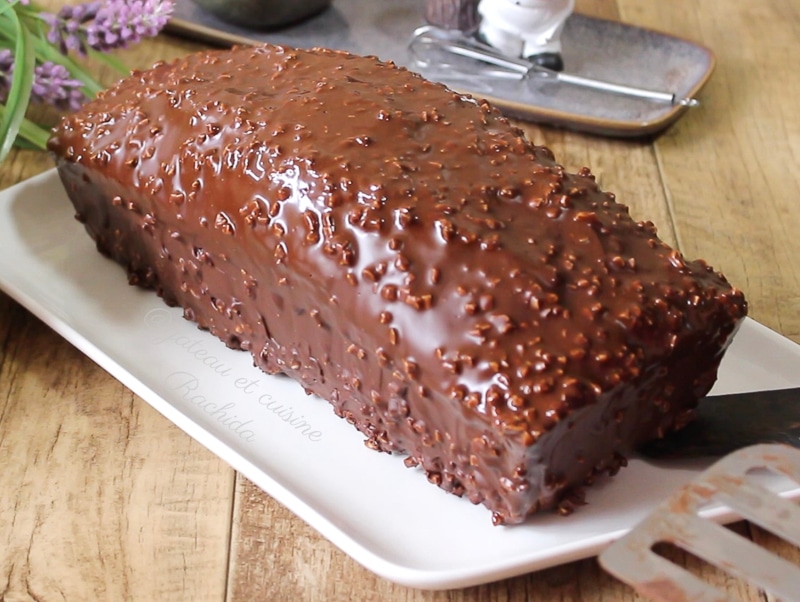

Best Moist Marble Loaf Cake Recipe
EQUIPEMENTS
INGREDIENTS
Marble Cake Batter (for 1 cake)
- 180 g soft butter (6.3 oz)
- 300 g sugar (10.6 oz)
- 3 eggs 150 g without shells (5.3 oz)
- 300 g all-purpose flour (10.6 oz)
- 9 g baking powder (0.3 oz)
- 3 pinches of fleur de sel or salt
- 300 ml heavy cream at room temperature (10.6 oz)
- 30 g unsweetened cocoa powder (1 oz)
- 15 g flour (0.5 oz)
- 2 teaspoons vanilla extract or the seeds of one and a half vanilla beans
Soaking Syrup (for 1 cake)
- 75 ml water (2.6 oz)
- 23 g sugar (0.8 oz)
- 1 teaspoon vanilla extract or 7 g rum (0.25 oz)
Dark Chocolate Ganache (if using a tube loaf pan)
- 150 g dark chocolate Guanaja 70% by Valrhona (5.3 oz)
- 185 ml heavy cream (6.5 oz)
- 30 g invert sugar or honey (1 oz)
Rocher Glaze (for 1 cake)
- 250 g dark and milk chocolate 150 g / 5.3 oz dark chocolate 70% and 100 g / 3.5 oz milk chocolate, or just dark chocolate (8.8 oz)
- 65 g (2.3 oz) finely diced blanched almonds roasted 15 minutes at 160°C/320°F
- 45 ml grapeseed or sunflower oil (1.6 oz)
PREPARATION
- Note: I recommend checking the steps with images and/or watching the video. The recipe might seem long, but that's simply because I’m explaining the steps for two different types of loaf pans.
- You can use a food processor (blender)or a stand mixer with a paddle attachment, like a KitchenAid, to prepare the batter.
- Cream the butter, sugar, and salt.
- Incorporate the sifted flour (300 g / 10.6 oz) with the baking powder and mix well.
- Add the eggs one at a time, mixing well after each addition.
- Gradually add the heavy cream once the eggs are fully incorporated into the batter. Mix well to obtain a smooth batter.
- Divide the batter into two equal parts (about 608 g / 21.5 oz each). To do this, weigh the empty bowl you'll use beforehand.
- You should end up with two portions of approximately 608 g (21.5 oz) each.
- Add the cocoa powder (30 g / 1 oz) to one portion and the 15 g (0.5 oz) of flour and vanilla to the other. Mix well.
- Divide the marble cake batter into two equal parts.
- Place each batter in a piping bag without a nozzle or a freezer bag.
- Grease and line the bottom and sides of a regular loaf pan, or grease the tube pan along with the tube and inside the lid. Line the bottom with parchment paper.
- Alternate between the vanilla and chocolate batters, starting by piping the vanilla batter in the shape of a W. Then pipe the chocolate batter in the same W shape on top. Watch the video for a clearer explanation.
- Tap the mold gently against the work surface to smooth the top.
- Place a small amount of softened butter into a small piping bag or a freezer bag. Pipe a thin line of butter down the center of the batter, along the entire length of the mold.
- Refrigerate the mold overnight, or place it in the freezer for 1 hour if you're in a hurry.
- After the chilling time, preheat the oven to 150°C (300°F) preferably with fan.
- Bake for 1 hour and 30 minutes. A skewer inserted into the center of the cake should come out dry.
- If you chose a loaf tube pan, proceed in the same way. Alternately pipe the two batters until you reach the hole, then insert the tube.
- Continue piping, alternating between the vanilla and chocolate batters.
- Tap the pan on the work surface to smooth the top, and close with the lid.
- Bake immediately for 1 hour and 30 minutes at 150°C (300°F) (fan-assisted oven preferred).
Soaking syrup:
- Prepare it a little before the end of the cake's baking time, as it should be lukewarm.
- Combine the water and sugar, and bring to a boil over medium heat. Stir to dissolve the sugar. Do not let it boil to avoid evaporating the water.
- Remove from heat and add the vanilla extract or rum.
The finishing :
- Unmold the marble cake onto a wire rack.
- For the cake with a tube, wait about ten minutes, then gently remove the tube by twisting it in one direction, then the other.
- Soak the warm cake with the lukewarm syrup on all sides (except the bottom).
- Wait for it to lose some steam, then wrap it completely in plastic wrap.
- Leave it until the next day or from morning to evening (minimum 4 hours) at room temperature.
Prepare the ganache
- The next day, prepare the dark chocolate ganache if you made a marble cake in the tube loaf pan. Otherwise, proceed directly to the chocolate Rocher glaze step.
- Melt the dark chocolate over a double boiler.
- Once the chocolate is melted, heat the heavy cream with the inverted sugar or honey.
- Add the hot cream to the melted chocolate in 3 or 4 stages. Stir with a spatula in a circular motion. The ganache may seem to separate, but don't worry, this is normal.
- Continue adding the rest of the cream until you have a smooth, glossy ganache.
- You can use an immersion blender, trying not to create air bubbles.
- Place the ganache in a piping bag.
- Remove the plastic wrap from the cake, then wrap one side of the cake tightly. If necessary, double the plastic wrap to seal the gap and prevent the chocolate ganache from spilling out.
- Place the cake vertically (standing upright) in a container that can hold it steady.
- Fill the hole with the ganache, which should be liquid but not too runny. Fill it to the top.
- Refrigerate for about 15 minutes and add more ganache if necessary, as it may settle slightly.
- Freeze the cake with the ganache in this position for 1 to 2 hours to make it easier to glaze.
- If you opted for a cake without ganache, freeze it as well for 1 to 2 hours.
- The thermal shock will allow the glaze to adhere to the cake, and this way, you can use the hot glaze. It will flow smoothly without forming any clumps of glaze on the cake.
Rocher Glaze
- Roast the Roast the finely diced blanched almonds for about 15 minutes in a preheated oven at 160°C (320°F) and let them cool.
- Melt the chocolate in a double boiler. When melted, add the oil and mix well.
- Remove from heat, add the toasted almonds and mix well.
- Place a wire rack on a tray lined with two sheets of aluminum foil. These two sheets will catch the glaze and allow you to pour it back over the cake.
- This step should be done quickly before the glaze sets on the cake.
- Remove the cake from the freezer and put it on the wire rack.
- Pour the glaze over the entire surface to cover it completely. Pour back any excess that has spilled onto the sheets. With this method, you'll have a generous layer of glaze.
- Tap the rack to spread the glaze evenly. I recommend not using a spatula. I did it on one side, and it left marks.
- Slide two large spatulas under the cake and transfer it to the serving platter. Do this once the rocher glaze has stopped flowing.
- Let it sit at room temperature before enjoying.
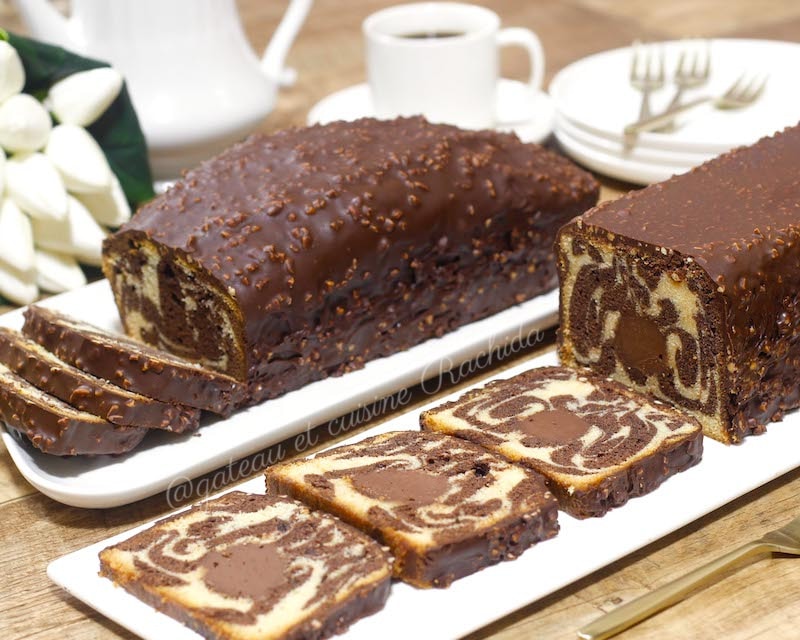
Thank you for visiting my blog and for your comments.
You can also follow me on my YouTube channel

